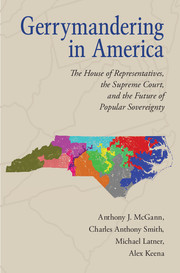 Gerrymandering in America
Gerrymandering in America Book contents
- Frontmatter
- Contents
- 1 The Unnoticed Revolution
- 2 The Jurisprudence of Districting
- 3 Measuring Partisan Bias
- 4 Geographic Explanations for Partisan Bias
- 5 Political Explanations of Partisan Bias
- 6 Constitutional Implications of Vieth: The Revenge of the Anti-Federalists
- 7 Answering Justice Scalia's Challenge to Equality: Does Equal
- 8 Conclusion: Vieth, Majority Rule, and One Person, One Vote
- Bibliography
- Index
8 - Conclusion: Vieth, Majority Rule, and One Person, One Vote
Published online by Cambridge University Press: 05 March 2016
- Frontmatter
- Contents
- 1 The Unnoticed Revolution
- 2 The Jurisprudence of Districting
- 3 Measuring Partisan Bias
- 4 Geographic Explanations for Partisan Bias
- 5 Political Explanations of Partisan Bias
- 6 Constitutional Implications of Vieth: The Revenge of the Anti-Federalists
- 7 Answering Justice Scalia's Challenge to Equality: Does Equal
- 8 Conclusion: Vieth, Majority Rule, and One Person, One Vote
- Bibliography
- Index
Summary
The Supreme Court's decision in Vieth v. Jubelirer (2004) and the partisan districting that followed the 2010 Census raise fundamental questions about American democracy. They force us to reconsider the principles of majority rule, equal protection, and one person, one vote. In an immediate sense, the current level of partisan gerrymandering challenges the principle of majority rule, in that control of the House may depend as much on how the districts are drawn as on how people vote, and a minority may often dominate a majority. However, the consequences of the Supreme Court's ruling are more profound than who controls the House for the next decade. The Vieth decision undermines the one-person, one-vote jurisprudence of the 1960s that began with Baker v. Carr (1962). The decision respects the finding in Wesberry and Reynolds that all districts have to have equal population. However, this requirement means little or nothing if state legislatures are able to use partisan gerrymandering to achieve the same ends. The fact that state legislatures can to a substantial degree fix the outcome of House of Representatives elections also subverts the Madisonian principle that at least one branch of the legislature should be chosen directly by the people. This marks a major change in the effective constitution of the United States.
However, before considering the broader significance of Vieth and the partisan bias that followed the 2010 districting round, we need to summarize the empirical findings of this book. We can confirm that partisan bias increased sharply in the 2010 districting round. We find that the bias of the House of Representatives in 2012 was around 9% (measured by asymmetry). Roughly speaking, this means that if there were a 50/50 vote split, one party would win 55% of the seats, while the other would get 45%. This compares to a 3% bias in the 2000 districting round. In many individual states, the bias is far, far greater. There are numerous states where the asymmetry is between 30% and 40%. Or, alternatively, one party can win between two-thirds to three-quarters of the seats with only half the votes. The immediate political implication of this bias is that the House of Representatives is likely to remain under Republican control for the next decade.
- Type
- Chapter
- Information
- Gerrymandering in AmericaThe House of Representatives, the Supreme Court, and the Future of Popular Sovereignty, pp. 225 - 236Publisher: Cambridge University PressPrint publication year: 2016


